Related Research Articles

Transport infrastructure in Brazil is characterized by strong regional differences and lack of development of the national rail network. Brazil's fast-growing economy, and especially the growth in exports, will place increasing demands on the transport networks. However, sizeable new investments that are expected to address some of the issues are either planned or in progress. It is common to travel domestically by air because the price is low. Brazil has the second highest number of airports in the world, after the USA.

Rio de Janeiro, or simply Rio, literally River of January, is the second-most populous city in Brazil and the sixth-most populous in the Americas. Rio de Janeiro is the capital of the state of the same name, Brazil's third-most populous state, after São Paulo and Minas Gerais. Part of the city has been designated as a World Heritage Site, named "Rio de Janeiro: Carioca Landscapes between the Mountain and the Sea", on 1 July 2012 as a Cultural Landscape.

The Xochimilco Light Rail is a light rail line that serves the southern part of Mexico City. It connects to, but is not considered a part of, the Mexico City Metro. Rather, it is operated by the Servicio de Transportes Eléctricos (STE), the authority that operates Mexico City's electric trolleybus system and formerly operated the municipal electric tram system.

The Rio de Janeiro Metro, commonly referred to as just the Metrô is a rapid transit network that serves the city of Rio de Janeiro, Brazil. The Metrô was inaugurated on 5 March 1979, and consisted of five stations operating on a single line. The system currently covers a total of 58 kilometres (36 mi), serving 41 stations, divided into three lines: Line 1 ; Line 2, which together travel over a shared stretch of line that covers 10 stations of an approximate distance of 5 kilometers; and Line 4. Metrô Rio has the second highest passenger volume of the metro systems in Brazil, after the São Paulo Metro.
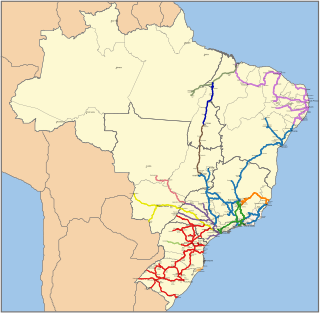
Rail transport in Brazil began in the 19th century and there were many different railway companies. The railways were nationalised under RFFSA in 1957. Between 1999 and 2007, RFFSA was broken up and services are now operated by a variety of private and public operators, including América Latina Logística, Companhia Paulista de Trens Metropolitanos and SuperVia.
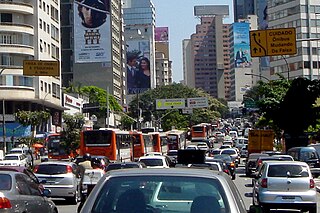
Transport in São Paulo plays a key role in the daily lives of the people of São Paulo and offers various methods of public transport that are offered in the city, including a complex bus system run by SPTrans, and various subway and railway lines. A contactless smartcard is used to pay fares for the buses, subway, and railway systems. São Paulo also has three airports.
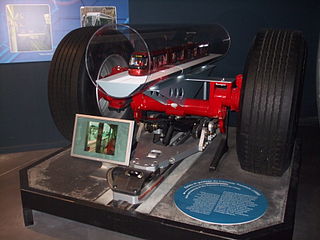
A rubber-tyred tram is a development of the guided bus in which a vehicle is guided by a fixed rail in the road surface and draws current from overhead electric wires.

The Santa Teresa Tram, or Tramway, is a historic tram line in Rio de Janeiro, Brazil. It connects the city centre with the primarily residential, inner-city neighbourhood of Santa Teresa, in the hills immediately southwest of downtown. It is mainly maintained as a tourist attraction and is nowadays considered a heritage tramway system, having been designated a national historic monument in 1985. The line has a very unusual gauge: 1,100 mm. The main line is 6.0 kilometres long.
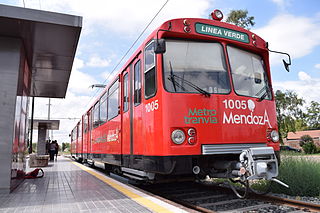
The Metrotranvía Mendoza is a public light rail transport system for the city of Mendoza, Argentina, served by articulated light rail cars operating on newly relaid tracks in former-General San Martín Railway mainline right-of-way.
Aldeia Campista was a neighborhood in Rio de Janeiro, Brazil, close to contemporary Vila Isabel, Tijuca, Maracanã and Andaraí.

Tramways & Urban Transit(TAUT or T&UT), also known as Modern Tramway, is a British monthly magazine about tramways and light rail transport, published continuously since 1938. Its content is orientated both to tramway enthusiasts and to persons working in the tram transport field or studying tramways. It has been issued monthly from the beginning. Although published in Britain, the magazine's coverage is international, and its regular "World News" column includes detailed news on electric trams and light rail worldwide.
The Brazilian municipal elections of 2012 took place on October 7 and on October 28. Over 138 million voters chose mayors, deputy mayors and city councillors for the 5,568 municipalities of Brazil. These were the first elections in which the recently registered parties Partido Pátria Livre (PPL) and Partido Social Democrático (PSD) participated; they were both recognized by the Superior Electoral Court in 2011. Political parties whose candidates wished to run for the 2012 elections had to be registered at the TSE for at least one year before the election date, while candidates also had to be affiliated to a party for the same period of time. Conventions for the selection of candidates within the parties occurred between 10 and 30 June, while the registry of candidates and alliances with the Regional Electoral Courts took place until July 5. Electoral campaign was authorized from the moment a candidacy had been registered. The free electoral program – two daily slots on free-to-air TV and radio for political advertising paid by the Electoral Justice fund – ran weekdays from 21 August until 4 October. According to the current Brazilian electoral law, the two-round system – should the leading candidate receive less than 50% +1 of the votes – is only available for cities with more than 200,000 voters. This includes all state capitals, with the exception of Boa Vista, Roraima and Palmas, Tocantins, plus 59 other municipalities. The free electoral program for the second round ran from 13 October until 26 October.
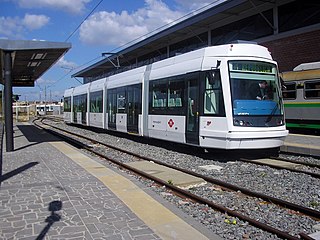
The Cagliari light rail system, commercially known as Metrocagliari, is a two-line light rail system that serves the town of Cagliari and part of its metropolitan area, in Sardinia, Italy. The system was inaugurated in 2008 and has subsequently been expanded to two lines.

Rio de Janeiro Light Rail is a modern light rail system serving Rio de Janeiro, Brazil. The system is among several new public transport developments in the region ahead of the city's successful bid for the 2016 Summer Olympics. Its official name is VLT Carioca, the initialism "VLT" being equivalent to the English term light rail.

The Oranjestad Streetcar is a single-track tram line in Oranjestad, the capital city of Aruba. It is owned and operated by Arubus, the national public transportation company. It was built as a key component of a larger project to upgrade the main retail areas of the town, other aspects of which included pedestrianization of streets, planting of trees, installation of ornamental street lighting and resurfacing of streets and sidewalks.

The TriMet transit system, serving the Portland metropolitan area in Oregon, owns and operates two different rail transit systems: a light rail system known as MAX and a commuter rail system known as WES. The fleet of 145 MAX light rail vehicles (LRVs) includes five different models, designated by TriMet as "Type 1" through "Type 5", all of which are used on all of the MAX lines. "Type 6" cars are on order and are due to replace the Type 1 cars in 2023–2024. The comparatively very small WES fleet includes three different types of commuter rail cars.

Dona Joaninha or Estrada de Ferro Sorocabana 6 is a steam locomotive that is now on static display in Guarulhos, Brazil. Constructed in 1940, it was used to move sugar cane across Brazil until the 1960s. A scrap dealer purchased it around 1976, and it was then put on static display around 2000. After falling into disrepair, it was restored in 2020.
References
- 1 2 3 4 5 6 7 8 9 10 11 12 13 14 15 16 17 18 19 Rio de Janeiro (2) on tramz.com
- 1 2 3 4 5 6 7 8 Rio de Janeiro (1) on tramz.com
- ↑ http://www.tramz.com/br/ss/ss40.html
- ↑ http://www.tramz.com/br/ss/st.html
- ↑ http://urbanrail.net/am/santos/santos.htm
- ↑ "Worldwide Review [regular news section]". Tramways & Urban Transit . UK: LRTA Publishing. November 2017. p. 430. ISSN 1460-8324.
- ↑ "Worldwide Review [regular news section]". Tramways & Urban Transit . UK: LRTA Publishing. February 2018. p. 69. ISSN 1460-8324.
- Books and periodicals shown in List of town tramway systems